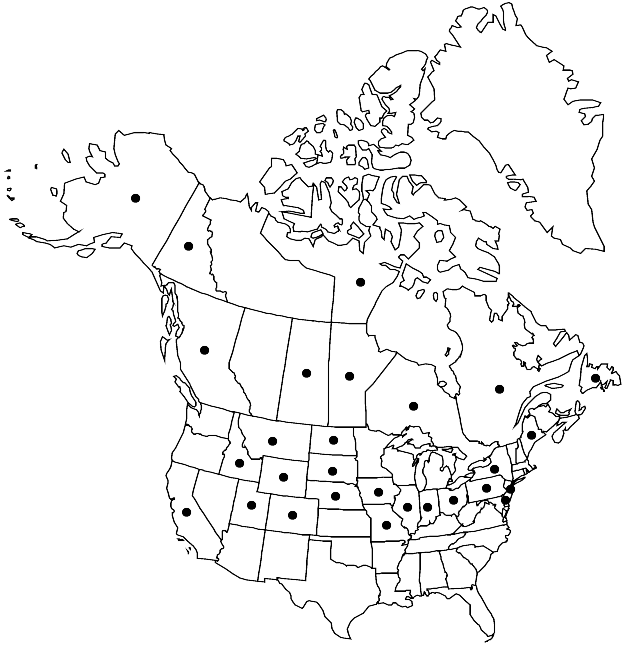Brachythecium acutum
Icon. Musc., suppl., 99. 1874.
Plants medium-sized to large, in loose to dense mats, yellowish to brownish. Stems to 7 cm, creeping, terete or occasionally subcomplanate-foliate, irregularly pinnate, branches to 8 mm, straight, terete to subcomplanate-foliate. Stem-leaves erect to erect-spreading, loosely imbricate to somewhat spaced, broadly to narrowly ovate-triangular, broadest at 1/10 leaf length or below, not concave, not or slightly plicate, 2–2.8 × 0.8–1.2 mm; base rounded, inconspicuously short-decurrent; margins plane, occasionally recurved distally, minutely and evenly serrulate to subentire; apex gradually tapered to narrow acumen or gradually acuminate, occasionally short-apiculate; costa to 60–70% leaf length, strong, terminal spine absent; alar cells subquadrate or short-rectangular, small to enlarged, 15–30 × 10–14 µm, walls moderately thick, region somewhat differentiated or almost undifferentiated, usually inconspicuous, of 4–7 × 5 cells, pellucid; laminal cells linear, 60–135 × 8–11 µm, walls not or moderately porose; basal-cells to 20–25 × 10–13 µm, region in 2–5 rows. Branch leaves with margins often recurved at base, usually less serrulate; basal laminal cells almost undifferentiated or alar region of 2–7 cells, pellucid, (often hidden by recurved margins). Sexual condition autoicous. Seta redbrown, 2–4 cm, smooth. Capsule inclined to horizontal, redbrown, ovate, slightly curved, 15–20 mm; annulus separating by fragments; operculum conic. Spores 13–18 µm.
Habitat: Wet soil, peat, fens, swamps, rotten logs in swampy forests
Elevation: low to moderate elevations (0-1000 m)
Distribution

B.C., Man., Nfld. and Labr. (Nfld.), Nunavut, Ont., Que., Sask., Yukon, Alaska, Calif., Colo., Del., Idaho, Ill., Ind., Iowa, Maine, Mo., Mont., Nebr., N.J., N.Y., N.Dak., Ohio, Pa., S.Dak., Utah, Wyo.
Discussion
Brachythecium acutum is distinguished by the evenly tapered, triangular, and weakly or not plicate leaves. Brachythecium acutum has been treated as an eplicate form of B. salebrosum (for example, H. A. Crum and L. E. Anderson 1981). This conclusion may have been based on the fact that sometimes, especially in drier habitats, its alar cells are relatively smaller and form a square group; this pattern is also known for the Eurasian B. mildeanum (Schimper) Schimper. However, optimally developed B. acutum is distinct in having homogeneous areolation across the leaf base, quite regularly triangular leaves, minute teeth along leaf margins, not or very weakly plicate leaves, and unusually long setae.
Selected References
None.
Lower Taxa
"long" is not a number."concave" is not a number."broad" is not a number.